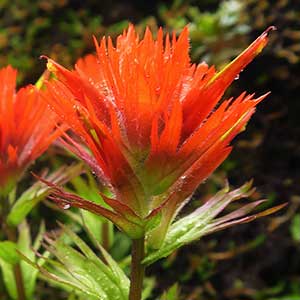Castilleja sessiliflora
Castilleja chambersii
downy paintedcup, Great Plains Indian paintbrush
Chambers' Indian paintbrush, Chambers' paintbrush
few to many, ascending to erect, often decumbent at base, unbranched, sometimes branched, hairs spreading, sometimes matted, short to medium length, ± soft, eglandular, often with a layer of minute-glandular hairs, sometimes woolly.
solitary or few to several, ascending, sometimes short-decumbent and rooting, branched from near base, sometimes distally, glabrous or glabrate with hairs very sparse, ± appressed, very short, soft, eglandular.
green to purple, or grayish with dust and hairs, linear to narrowly lanceolate, (1–)2–5(–6) cm, not fleshy, margins plane, involute, (0–)3–5-lobed, apex acuminate to acute;
lobes divergent, spreading, linear, apex acute.
green, often brown- or purple-tinged, oblong to lanceolate to narrowly ovate or ovate, (1–)2–5.8 cm, not fleshy, margins plane, ± involute, deeply 3–7(–11)-lobed, sometimes with secondary lobes, apex narrowly acute;
lobes erect to ascending, lanceolate to linear-lanceolate to oblanceolate, apex acute.
3–18 × 2.5–6.5 cm;
bracts green to purplish throughout, sometimes reddish brown, pink, or lavender throughout, or distally white or pale yellow, sometimes distally dull pink, pink, salmon, orangish, pale pink-orange, buff, or cream, lanceolate, similar to distal leaves, 3(–5)-lobed;
lobes spreading, linear-lanceolate, long, arising at or below mid length, apex acute to acuminate, sometimes obtuse.
3–15 × 2–4.5 cm;
bracts proximally greenish, distally bright red, scarlet, or pale reddish orange, rarely orange-yellow, often fading to pale yellowish orange with age, obovate to orbicular, fan-shaped, (3–)5–9(–13)-lobed, sometimes with secondary lobes;
lobes erect or ascending, lanceolate to triangular, short and medium length, usually arising at or above mid length, rarely below, apex acute.
strongly curved distally, 35–55 mm;
tube 24–45 mm;
abaxial lip, beak, and distal portion of tube exserted;
beak adaxially green, yellow, pinkish, purplish, or whitish, 9–15 mm;
abaxial lip green, pale green, or purple, protruding, shelflike, 4–8 mm, 50–70% as long as beak;
teeth spreading, white, pale yellow, pink, or purple, 3–4 mm.
straight, 30–45 mm;
tube 14–19 mm;
beak long-exserted, adaxially green or yellow-green to brownish, 18–24 mm;
abaxial lip deep green, reduced, 1–3 mm, 10% as long as beak;
teeth incurved, greenish to dull purplish, 0.5–1.5 mm.
colored as bracts, sometimes proximally white, 20–40 mm;
abaxial and adaxial clefts 12–20 mm, 40–60% of calyx length, deeper than laterals, lateral 5–15 mm, 10–25% of calyx length;
lobes linear, apex acute to acuminate.
proximally green, sometimes purple to brown, distally colored as bracts, 20–30 mm;
abaxial and adaxial clefts 7–14 mm, ca. 33% of calyx length, deeper than laterals, lateral 2–4 mm, 10–15% of calyx length;
lobes triangular, barely longer than wide, apex acute or acuminate to obtuse.
= 24.
= 24.
Castilleja sessiliflora
Castilleja chambersii
Castilleja sessiliflora ranges across the Great Plains from southern Canada to northern Mexico, where it is apparently rare. In Texas and northern Mexico, its range overlaps with the similar C. mexicana. Most populations of C. sessiliflora, especially north of Texas, have white to pale yellow inflorescences; in southwestern Texas they are more variable in color, with pink-purple plants often predominating locally. Those plants with pink-purple inflorescences were named forma purpurina by F. W. Pennell. In the limestone deserts of southern New Mexico and southeastern Arizona, the inflorescences are often a pale pink-orange, but these are intermingled with more typical greenish white plants. Occasional hybrids between C. angustifolia var. dubia and C. sessiliflora are known from northeastern Wyoming.
(Discussion copyrighted by Flora of North America; reprinted with permission.)
Castilleja chambersii is limited to the summits of three volcanic peaks in the northern Coast Range of Clatsop County, Oregon, and at one similar area in nearby Pacific County, Washington. It is similar to C. rupicola, and the two likely share a common ancestor. Disturbance and erosion from logging and road construction represent significant threats to C. chambersii. Populations of C. chambersii often grow near and even alongside C. hispida, but hybrids are rare.
(Discussion copyrighted by Flora of North America; reprinted with permission.)
